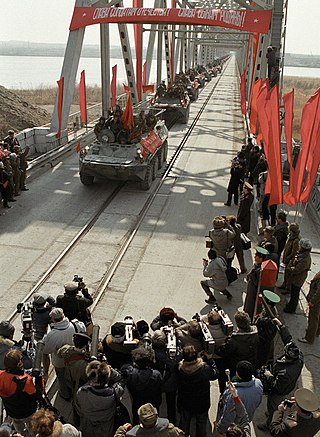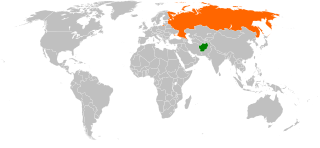
Afghanistan, officially the Islamic Emirate of Afghanistan, is a landlocked country located at the crossroads of Central Asia and South Asia. Referred to as the Heart of Asia, it is bordered by Pakistan to the east and south, Iran to the west, Turkmenistan to the northwest, Uzbekistan to the north, Tajikistan to the northeast, and China to the northeast and east. Occupying 652,864 square kilometers (252,072 sq mi) of land, the country is predominantly mountainous with plains in the north and the southwest, which are separated by the Hindu Kush mountain range. Kabul is the country's largest city and serves as its capital. According to the World Population review, as of 2023, Afghanistan's population is 43 million. The National Statistics Information Authority of Afghanistan estimated the population to be 32.9 million as of 2020.

The history of Afghanistan, preceding the establishment of the Emirate of Afghanistan in 1823 is shared with that of neighbouring Iran, central Asia and Indian subcontinent. The Sadozai monarchy ruled the Afghan Durrani Empire, considered the founding state of modern Afghanistan.
The Military history of Afghanistan began before 1709 when the Hotaki dynasty was established in Kandahar followed by the Durrani Empire. The Afghan military was re-organized with assistance from the British in 1880, when the country was ruled by Amir Abdur Rahman Khan. It was modernized during King Amanullah Khan's rule in the early 20th century, and then during King Zahir Shah's forty-year rule; the Soviet Union supplied almost all weapons, training and military needs between the 1950s and 1970s. From 1978 to 1992, the Soviet-backed Afghan Armed Forces engaged in heavy fighting with the multi-national mujahideen groups who were then backed by the United States, Pakistan and others. After President Najibullah's resignation in 1992 and the end of Soviet support, the Afghan military dissolved into portions controlled by different factions. This era was followed by the Taliban regime, whose leaders were trained and influenced by the Pakistan Armed Forces.

Gulbuddin Hekmatyar is an Afghan politician, and former mujahideen leader and drug trafficker. He is the founder and current leader of the Hezb-e-Islami Gulbuddin political party, so called after Mohammad Yunus Khalis split from Hezbi Islami in 1979 to found Hezb-i Islami Khalis. He has twice served as Prime Minister during the 1990s.
Milton Bearden is an American author, film consultant, and former CIA officer. Bearden served as the president and CEO of the Asia-Africa Projects Group, a Washington, D.C.-based firm that provides resource development and advisory services, from 2010 to 2015. He has been engaged in authorship and film consultancy since 1998. As of 2016, Bearden resides in Austin, Texas with his wife, Marie-Catherine, a retired university professor -- Georgetown University and The University of Texas at Austin -- and currently a professional consultant on inter-cultural protocols and etiquette.

Kandahār is one of the thirty-four provinces of Afghanistan, located in the southern part of the country, sharing a border with Pakistan, to the south. It is surrounded by Helmand in the west, Uruzgan in the north and Zabul Province in the east. Its capital is the city of Kandahar, Afghanistan's second largest city, which is located on the Arghandab River. The greater region surrounding the province is called Loy Kandahar. The Emir of Afghanistan sends orders to Kabul from Kandahar making it the de facto capital of Afghanistan, although the main government body operates in Kabul. All meetings with the Emir take place in Kandahar, meetings excluding the Emir are in Kabul.

Asadabad, also called Chaghasarai (چغسرای), is the capital city of Kunar Province in Afghanistan. It is located in the eastern-northeastern portion of the country. The city is located within a valley at the confluence of the Pech River and Kunar River between two mountain ridgelines running along both sides of the valley from Northeast to Southwest.

Shortly after the September 11 attacks, the United States declared the war on terror and subsequently led a multinational invasion of Taliban-ruled Afghanistan. The stated goal was to dismantle al-Qaeda, which had executed the attacks under the leadership of Osama bin Laden, and to deny Islamist militants a safe base of operations in Afghanistan by toppling the Taliban government. The United Kingdom was a key ally of the United States, offering support for military action from the start of the invasion preparations. The American military presence in Afghanistan greatly bolstered the Northern Alliance, which had been locked in a losing fight with the Taliban during the Afghan Civil War. Prior to the beginning of the United States' war effort, the Taliban had seized around 85% of Afghanistan's territory as well as the capital city of Kabul, effectively confining the Northern Alliance to Badakhshan Province and smaller surrounding areas. The American-led invasion on October 7, 2001, marked the first phase of what would become the 20-year-long War in Afghanistan.

Relations between Afghanistan and the United States began in 1921 under the leaderships of King Amanullah Khan and President Warren G. Harding, respectively. The first contact between the two nations occurred further back in the 1830s when the first recorded person from the United States explored Afghanistan. The United States government foreign aid program provided about $500 million in aid for economic development; the aid ended before the 1978 Saur Revolution. The Soviet invasion of Afghanistan in 1979 was a turning point in the Cold War, when the United States started to financially support the Afghan resistance. The country, under both the Carter and Reagan administrations committed $3 billion dollars in financial and diplomatic support and along with Pakistan also rendering critical support to the anti-Soviet Mujahideen forces. Beginning in 1980, the United States began admitting thousands of Afghan refugees for resettlement, and provided money and weapons to the Mujahideen through Pakistan's Inter-Services Intelligence (ISI). The USSR withdrew its troops in 1989.
In the late 1990s, some journalists used the expression "New Great Game" to describe what they proposed was a renewed geopolitical interest in Central Asia based on the mineral wealth of the region.
Afghan Arabs are Arab and other Muslim Islamist mujahideen who came to Afghanistan during and following the Soviet–Afghan War to aid the war efforts of native Muslims in the DRA. Despite being called "Afghan" they were not from Afghanistan nor legally citizens of Afghanistan.

Pursuant to the Geneva Accords of 14 April 1988, the Soviet Union conducted a total military withdrawal from Afghanistan between 15 May 1988 and 15 February 1989. Headed by the Soviet military officer Boris Gromov, the retreat of the 40th Army into the Union Republics of Central Asia formally brought the Soviet–Afghan War to a close after nearly a decade of fighting. It marked a significant development in the Afghan conflict, having served as the precursor event to the First Afghan Civil War.

The Afghanistan conflict began in 1978 and has coincided with several notable operations by the United States (U.S.) Central Intelligence Agency (CIA). The first operation, code-named Operation Cyclone, began in mid-1979, during the Presidency of Jimmy Carter. It financed and eventually supplied weapons to the anti-communist mujahideen guerrillas in Afghanistan following an April 1978 coup by the People's Democratic Party of Afghanistan (PDPA) and throughout the nearly ten-year military occupation of Afghanistan by the Soviet Union (U.S.S.R.). Carter's successor, Ronald Reagan, supported an expansion of the Reagan Doctrine, which aided the mujahideen along with several other anti-Soviet resistance movements around the world.

Relations between Afghanistan and Russia first emerged in the 19th century. At the time they were placed in the context of "The Great Game", Russian–British confrontations over Afghanistan from 1840 to 1907. The Soviet Union was the first country to establish diplomatic relations with Afghanistan following the Third Anglo-Afghan War in 1919. On 28 February 1921, Afghanistan and the Soviet Russia signed a Friendship Treaty. The Soviet Union intervened in Afghanistan against the Basmachi movement in 1929 and 1930.

The Afghan conflict refers to the series of events that have kept Afghanistan in a near-continuous state of armed conflict since the 1970s. Early instability followed the collapse of the Kingdom of Afghanistan in the largely non-violent 1973 coup d'état, which deposed Afghan monarch Mohammad Zahir Shah in absentia, ending his 40-year-long reign. With the concurrent establishment of the Republic of Afghanistan, headed by Mohammad Daoud Khan, the country's relatively peaceful and stable period in modern history came to an end. However, all-out fighting did not erupt until after 1978, when the Saur Revolution violently overthrew Khan's government and established the Democratic Republic of Afghanistan. Subsequent unrest over the radical reforms that were being pushed by the then-ruling People's Democratic Party of Afghanistan (PDPA) led to unprecedented violence, prompting a large-scale pro-PDPA military intervention by the Soviet Union in 1979. In the ensuing Soviet–Afghan War, the anti-Soviet Afghan mujahideen received extensive support from Pakistan, the United States, and Saudi Arabia in a joint covert effort that was dubbed Operation Cyclone.

Islamic Republic of Afghanistan nationality law is regulated by the Constitution of Afghanistan, as amended; the Citizenship Law of the Islamic Republic of Afghanistan and its revisions; the Afghan Civil Code; and various international agreements to which the country is a signatory. These laws determine who is, or is eligible to be, an Afghan national. The legal means to acquire nationality, formal legal membership in a nation, differ from the domestic relationship of rights and obligations between a national and the nation, known as citizenship. Nationality describes the relationship of an individual to the state under international law, whereas citizenship is the domestic relationship of an individual within the nation. Some countries use the terms nationality and citizenship as synonyms, despite their legal distinction and the fact that they are regulated by different governmental administrative bodies.
Throughout the history of Afghanistan, there have been many flags used by rebel groups in Afghanistan's various conflicts. This is a list of the Afghan rebel flags flown by various groups throughout the country's history.
The politics of Afghanistan are based on a totalitarian emirate within the Islamic theocracy in which the Taliban Movement holds a monopoly on power. Dissent is not permitted, and politics are mostly limited to internal Taliban policy debates and power struggles. As the government is provisional, there is no constitution or other basis for the rule of law. The structure is autocratic, with all power concentrated in the hands of the supreme leader and his clerical advisors. According to the V-Dem Democracy indices Afghanistan was as of 2023 the 4th least electoral democratic country in the world.
The following is an outline of the series of events that led up the War in Afghanistan (2001–2021).












